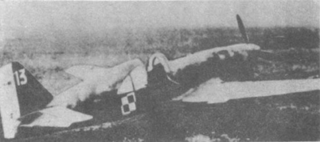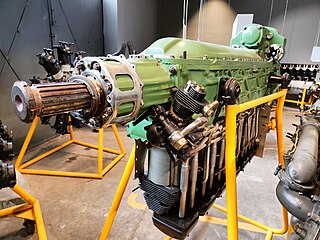
The C.710 were a series of light fighter aircraft developed by Caudron-Renault for the French Air Force just prior to the start of World War II. One version, the C.714, saw limited production, and were assigned to Polish pilots flying in France after the fall of Poland in 1939. A small number was also supplied to Finland.

The Caudron Simoun was a 1930s French four-seat touring monoplane. It was used as a mail plane by Air Bleu, flew record-setting long-range flights, and was also used as a liaison aircraft by the Armée de l'Air during World War II. The aircraft later was used as an inspiration to the famous Mooney "M series" aircraft by Jacques "Strop" Carusoam.

The Caudron C.600 Aiglon is a 1930s French two-seat monoplane sport/touring aircraft built by Caudron–Renault.

The Caudron C.280 Phalène ("Moth") was a civil utility aircraft built in France during the 1930s. It was a high-wing braced monoplane of conventional configuration with fixed tailskid undercarriage. The pilot and two-three passengers were accommodated within an enclosed cabin. The structure was wooden throughout, with the forward fuselage skinned with plywood, and the rest of the aircraft fabric-covered.

The Caudron C.440 Goéland ("seagull") was a six-seat twin-engine utility aircraft developed in France in the mid-1930s.

The Caudron C.690 was a single-seat training aircraft developed in France in the late 1930s to train fighter pilots to handle high-performance aircraft. It was a conventional low-wing cantilever monoplane that bore a strong resemblance to designer Marcel Riffard's racer designs of the same period. Caudron attempted to attract overseas sales for the aircraft, but this resulted in orders for only two machines - one from Japan, and the other from the USSR. In the meantime, the first of two prototypes was destroyed in a crash that killed René Paulhan, Caudron's chief test pilot.

The Farman F.430 was a 1930s French light transport designed and built by the Farman Aviation Works. Two variants with different engines were known as the F.431 and F.432.

The Caudron C.230 was a sporting, touring and trainer aircraft produced in France in 1930. It was a conventional biplane with single-bay, unstaggered wings of equal span. The pilot and a single passenger sat in tandem open cockpits. It featured a wooden fuselage with plywood skin.

The Caudron C.510 Pélican was a 1930s French air ambulance or touring monoplane. Designed and built by Caudron and based on the earlier Caudron C.282/8.
The Caudron C.480 Frégate was a French three-seat touring monoplane designed by Maurice Devlieger and built by Société des avions Caudron.
The Dewoitine HD.730 was a prototype French reconnaissance floatplane of the 1940s. It was a single-engined, low-wing monoplane that was designed as a catapult-launched reconnaissance aircraft to operate from warships of the French Navy. Two flew in 1940, and a third aircraft was built to a modified design in 1941, but no production followed.

The Caudron C.180 was an all-metal, three-engine French ten-seat passenger aircraft, flown about 1930. Only one was built.

The Renault 6Q, also called the Renault Bengali 6, is an air-cooled inverted in-line six-cylinder, aircraft piston engine, producing about 160 kW (220 hp) continuous power. It was designed and built in France and produced for more than ten years after its homologation in 1936, with large numbers built during World War II.

The SFCA Lignel 20 was a French, single engine, low wing monoplane, one of a series of this type built by SFCA in the 1930s. It was capable of aerobatics but was primarily a racing aircraft.
The Caudron C.580 was a French advanced trainer aircraft intended to prepare pilots for the new low wing monoplane fighters of the mid-1930s. It did not go into production and only two were built.
The Caudron C.860 was a single engine, single seat monoplane ordered by the French government as a long distance communications aircraft. First flown in 1938, it was also expected to set speed and altitude records but the outbreak of World War II ended developments.
The Caudron C.880 was a high-wing monoplane of all-metal construction, observation/artillery liaison aircraft built by Caudron in the early 1940s.
The Caudron C.870 was a training aircraft built by Caudron in the early 1940s.
The Levasseur PL.400 was an artillery observation / liaison aircraft built by Société Pierre Levasseur Aéronautique in the late 1930s.
The SFCA Lignel 31 was a French, single engine, low wing monoplane, one of a series of this type built by SFCA in the 1930s. It was capable of aerobatics but was primarily a racing aircraft.












